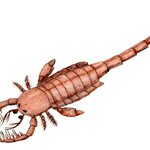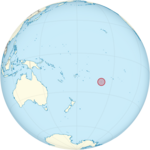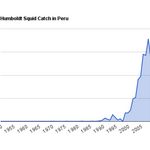Ecology & Zoology
I have a love/hate relationship with advertising. Ads are specifically designed to manipulate people, and I hate being manipulated. On the other hand, I love using free services that are supported by ads.
Science 2.0, as you may have noticed, runs ads, and I've got no problem with that. In fact, those ads make me anywhere from $3 to $10 a month--which isn't really enough to feed my ice cream habit, though it's a worthy contribution.
But the video ads were getting a little too intrusive, according to both my own experience and comments from you, dear readers. I mentioned this to Mr.…
Times are tough all over. But did you know that the Atlantic longfin squid is doing its part to help the economy?
In an article by Kirk Moore of Asbury Park Press about the decline of river herring in New Jersey, I learned that river herring spend months feeding in the open ocean. While they're stuffing their faces, they sometimes get accidentally caught, killed and discarded as bycatch. Local authorities are considering restrictions to reduce this loss . . .
Those measures are aimed primarily at a fleet of bigger boats, called mid-water trawlers because they pull nets at middle depths to…

Here at Squid A Day, we are all about the cephalopods. Specifically, the decapod cephalopods, the ones with ten appendages (eight arms and two tentacles). That's my tenuous excuse for veering off in an entirely different phylogenetic direction this evening . . .
You see, decapods are also a branch of crustaceans--all your friendly ten-legged crabs and lobsters. And crustaceans are arthropods. And the most awesome arthropods are undoubtedly the eurypterids. They're extinct now, but they once grew larger than humans. How is that not awesome?Nobu Tamura www.palaeocritti.com
And one of…

On October 8th, Octopus Day, I wrote about the incredibly strange Seven-arm Octopus, Haliphron atlanticus. I invoked its tremendous size, irregular arms, habitat flexibility, and peculiarly small body as proof positive of its weirdness.
But I didn't provide very satisfying pictures.
Today I am here to fill that gap with a couple of beautiful photographs taken by Nan Hauser, director of the Cook Islands Whale Research Project.
For anyone who's forgotten where the Cook Islands are.
Despite its Latin name, Haliphron atlanticus lives in all the world's oceans. On Septebmer 28th, Nan…

In an obituary for biologist Robert Clarke published recently in Marine Mammal Science, I read a rather curious passage about this scientist's observations of Humboldt squid:
During these voyages [off Peru and Ecuador] he noticed that the population of Humboldt giant squid,Dosidicus gigas, had been severely depleted owing to its excessive exploitation during the 1990s by factory ships from South Korea and Japan. Prey depletion may have forced the sperm whale of the Southeast Pacific to migrate to other seas to feed. This seemed to be corroborated in a paper by Jaquet et al. (…
Today's post in honor of the 2011 Cephalopod Awareness Days. October 12th is Fossil Day.I must confess, I'm glad today is the last of the Cephalopod Days. This heady pace is almost more than I can handle! The final day of ICAD is for celebrating fossil cephalopods, timed to coincide with National Fossil Day, which is totally a real thing. (Not that the other Cephalopod Days aren't a real thing, they're just differently real.)I'm going to continue the celebration of hypothetical fossil cephalopods, begun yesterday, with an exclusive quote from Sarah McMenamin…
Today's post in honor of the 2011 Cephalopod Awareness Days. October 12th is Fossil Day.I must confess, I'm glad today is the last of the Cephalopod Days. This heady pace is almost more than I can handle! The final day of ICAD is for celebrating fossil cephalopods, timed to coincide with National Fossil Day, which is totally a real thing. (Not that the other Cephalopod Days aren't a real thing, they're just differently real.)I'm going to continue the celebration of hypothetical fossil cephalopods, begun yesterday, with an exclusive quote from Sarah McMenamin…
Today's post in honor of the 2011 Cephalopod Awareness Days. October 12th is Fossil Day.I must confess, I'm glad today is the last of the Cephalopod Days. This heady pace is almost more than I can handle! The final day of ICAD is for celebrating fossil cephalopods, timed to coincide with National Fossil Day, which is totally a real thing. (Not that the other Cephalopod Days aren't a real thing, they're just differently real.)I'm going to continue the celebration of hypothetical fossil cephalopods, begun yesterday, with an exclusive quote from Sarah McMenamin…

Today's post in honor of the 2011 Cephalopod Awareness Days. October 11th is Myths and Legends Day.And what better way to celebrate than with an account of the newly discovered Triassic Kraken, you know, the one who made a self-portrait with the vertebral discs of dinosaurs a couple of millions years ago?
The evidence is at Berlin-Ichthyosaur State Park in Nevada, where McMenamin and his daughter spent a few days this summer. It's a site where the remains of nine 45-foot (14-meter) ichthyosaurs, of the species Shonisaurus popularis can be found. . . . Among the…

Today's post in honor of the 2011 Cephalopod Awareness Days. October 10th is Squid Day.It's the happiest day of the year here at Squid A Day! To celebrate (or perhaps it was just a coincidence) I attended Litquake's New Writers Workshop to get some tips on publishing my squid racing novel. The writers, agents, and publishers on the panels were very generous with their time and their advice; I came away with pages of useful notes.
However, as a result, I'm too wiped out to write a big exciting squid science post. Even though some great squid science stories are begging to…